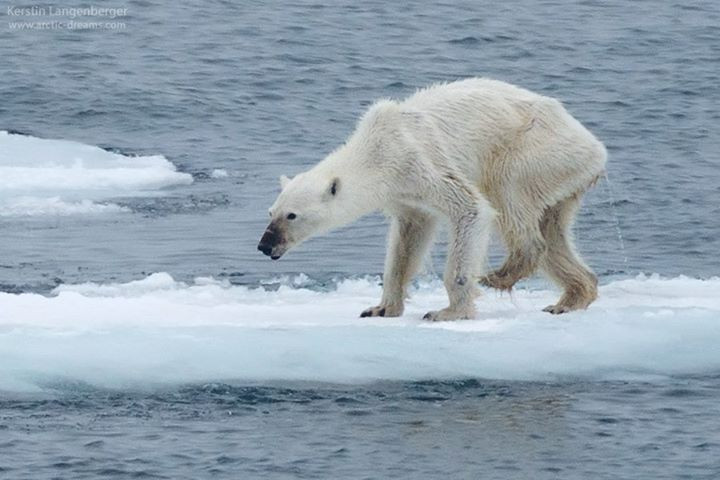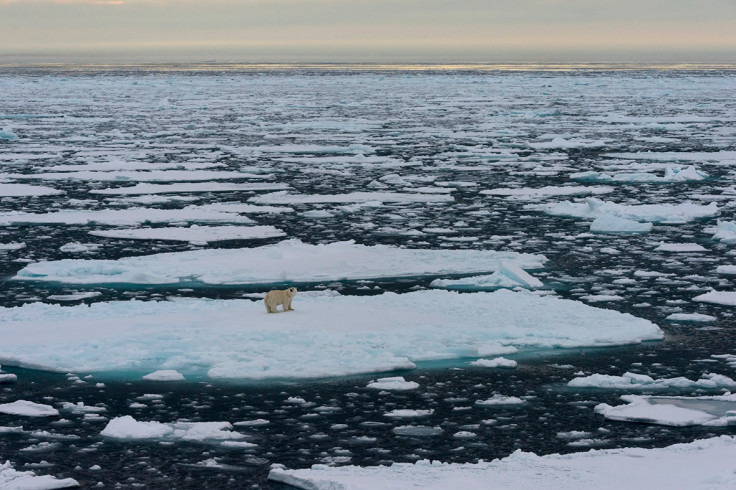I feel honoured my emaciated polar bear picture sparked climate change debate
Photographer Kerstin Langenberger's picture went viral after she posted it on Facebook

It is hard to put me into a box. People always ask me: "How do you make a living? And where's home?" Depending on the time of the year, I'll give different answers. I do work as a photographer and guide in the Arctic and Antarctic, and a few weeks each year I'll be in Iceland or my original home country, Germany. Home is wherever my camera bag is. It's that simple.
I've always been a nature lover and on top of that a critically minded environmentalist. As such I usually speak my mind and present my photography with texts that explain nature or make people aware of environmental issues. When I came back from a trip this past July, I felt the urge to inform my Facebook friends of what I had seen: the most pitiful polar bear you can imagine.
I accompanied a group of tourists on an expedition ship that was sailing through Hinlopen Strait, between the islands of Spitsbergen and Nordaustland, part of the Svalbard archipelago. Some occasional ice flows were drifting on the calm water: the remnants of the sea ice, which breaks up and melts over the summer time. And there, suddenly, was this bear resting on a tiny ice floe.
It stood up – and that was when we realized how thin it was. This animal was only skin and bones, it was on the brink of death. Our captain and expedition leader did the only reasonable thing: they turned the ship and left the bear immediately, in order not to disturb it any more. We all felt pity for that poor animal.
So why do I connect a thin bear with climate change, if I cannot prove it? The answer is simple: this is not the first thin bear I've seen. With the melting sea ice, more and more bears are stranded on land where there's hardly any food to be found.
As a nature lover and landscape photographer, I usually tend to show the beautiful side of nature. But if I witness inconvenient things, I am not afraid, to show these, either. And that's why I decided to upload the picture of the bear, together with a text on climate change, on my Facebook page.
After a few hours, the clicks went up, and after a day, the image went viral. By then I had to leave civilization again, as my next trip just started. Out in the Arctic wilderness, there's no communication to the outside world apart from satellite phone: no mobile phone coverage, no emails to your loved ones. And definitely no Facebook.
So when I returned 20 days later, I could not believe what had happened. The picture of the polar bear got seven million views, 50,000 shares and more than 5,000 comments. On top of that, international media had started to talk about it, too.

It would have been an understatement to say that I was surprised. I knew the image was special and shocking, but I never expected it to become so popular. It did exactly what I had wished for from the beginning: to start a discussion about climate change. I just never imagined that it would reach such an audience and spark such a storm of comments and reactions.
Sure enough, this image got people divided. I have to admit that I only briefly read over the first few hundred comments – it was just too much. Many emotional but also naïve comments. And amazingly many aggressive and ill-tempered grumps questioning everything.
Many called the image photoshopped, which is total nonsense and can easily be disproved as there were 50 of us on the ship who saw (and photographed) the bear. Others claimed the animal was old and therefore thin, starving because of lost teeth.
Well, I cannot ask the bear (which is very likely dead by now, anyway), but I believe it was injured, not old. I cannot proof that, either, as I spent a very short time with the bear and only have about a dozen images of it. It might just as well have been totally undernourished because of a long history of low hunting success. Who knows?
So why do I connect a thin bear with climate change, if I cannot prove it? The answer is simple: this is not the first thin bear I've seen. With the melting sea ice, more and more bears are stranded on land where there's hardly any food to be found.
Polar bears hunt seals, but seals stick to the sea ice. So a bear stuck on land far away from the ice will have less hunting opportunities and therefore starve, while those bears that stay on the ice tend to be nice and fat. Observations of thin, starving and dead bears have become more common in recent years.
A picture from the most amazing close-up polar bear encouter ever: a 1.5 year old bear cub desperately trying to figure...
Posted by Kerstin Langenberger Photography on Friday, July 24, 2015
Maybe I cannot prove that this individual polar bear had starved because of climate change: but it surely gave a face to those many animals that die directly or indirectly because of climate change. This image is so powerful: it sums up what is happening in the Arctic. It's a representative of a bigger problem: an ecosystem that is undergoing huge changes and which will disappears when the temperatures rise – together with amazing lifeforms like polar bears.
I have spent all of my adult life in the Arctic, and I know for sure that climate change is happening. It's so obvious if you spend some time up here and observe with an open mind. I also believe with all my heart that humanity is the main cause for the rising temperatures: and that we, that are so clever and consider ourselves the pride of creation, have an ethical commitment to try to minimize climate change.
To me, global warming is the biggest issue of our time, and climate activism is the most important form of nature conservation. That's why I feel honoured that this photo started a discussion about climate change again, and that, maybe, it might be the final reason for some people starting to change something at home.
There's many ways to reduce one's carbon footprint: everybody can contribute. Every single gram of CO2, that is not blown into the atmosphere, will help to slow down global warming – it's as easy as that!
Kerstin Langenberger is a nature photographer and environmentalist who has lived in the Arctic her entire adult life. You can find out more at her website arctic-dreams.com
© Copyright IBTimes 2025. All rights reserved.






















